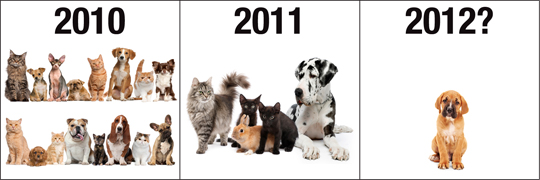HSUS's ‘Direct Care’ for Animals is Plummeting
Despite HSUS’s recent claim that it “provides direct care to more animals than any organization in the nation,” we’ve shown that local groups like the Houston SPCA care for just as many or more animals on a significantly slimmer budget. Now we’ve noticed something new: As of December 29, HSUS reported that it had cared for “more than 60,000” animals in 2011. That’s way down from 2010, when HSUS says it cared about 100,000.
In other words, the amount of “direct care” to animals provided by the Humane Society of the United States dropped by about 40 percent—in a single year.
That’s really too bad. As critical as we are of HSUS (we are a watchdog group, after all), we’ve given it a thumbs up for its direct-care programs. Hopefully this trend reverses in 2012.
According to HSUS’s 2010 annual report, the breakdown of its direct care that year is roughly: 11,000 animals helped via the Animal Rescue Team; 68,000 through spay/neuter surgeries during “Spay Day”; 6,400 from animal fighting investigations; and 16,000 in HSUS’s wildlife care centers and horse sanctuaries.
How does 2011 match up? (HSUS’s 2011 annual report isn’t published yet, so we’re going by available data.)
- Animal Rescue Team: 8,000 (a drop of 27 percent)
- Spay Day: 48,000 (a decline of 29 percent)
- Investigations and care centers (the remainder): About 5,000 (a decline of 77 percent)
It’s also interesting to note that “Spay Day”—which is a big PR event for HSUS—accounted for 80 percent of the animals HSUS provided “hands-on care” for.
Why is this significant? Because “Spay Day” isn’t long-term care. It’s a one-off event, and it seems that HSUS isn’t as effective as the Doris Day Animal League was in running Spay Day (HSUS took over the event in 2006 after the groups merged).

Remember, HSUS doesn’t run a single pet shelter, and the animals it does provide long-term care for generally are not dogs and cats. Yet, more than 85 percent of the animals in HSUS’s TV appeals are cats and dogs. According to public polling, most Americans mistakenly believe HSUS is a pet-shelter umbrella group and that HSUS gives most of its money to pet shelters.
HSUS’s ads clearly fuel this misconception for HSUS’s gain. And in the meantime, HSUS’s actual direct care—for cats, dogs, and all animals—is falling rapidly. We’ll have more analysis as more information becomes available, but it’s worth wondering: Could the decline in direct care indicate that HSUS’s budget dropped significantly in 2011?
As long as hands-on care isn’t a top priority at HSUS—it still doesn’t run a single pet shelter—the rule remains: If you want to help with the care of pets, give to a local group



